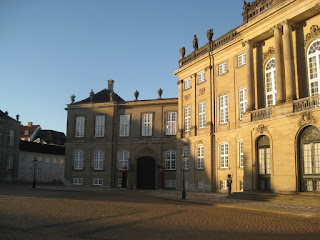It is important to understand the history of Copenhagen’s development in order to understand the relationships between districts, their evolution over time, and the evolution of housing types that appeared within these districts. In this section I will briefly outline Copenhagen’s history, in order to situate the case studies within it.
Land
Copenhagen
is located on the eastern edge of the island called Zealand in Denmark and
spans to the adjacent smaller Amager Island. Zealand is the largest island in
Denmark, and lies between the peninsula of Jutland, the largest body of land in
Denmark, and Sweden. Between it and Sweden runs the Øresund, the most favorable
channel for navigation between the North Sea and the Baltic.
In
general Denmark is a very flat country, with few hills and shallow coastal
waters. This has meant that it is relatively easy to build artificial land in
the midst of coastal waters, creating a very malleable coastline that has been
extensively shaped by human artifice over time. This is especially true in
Copenhagen, large sections of which are on land “reclaimed” from the sea.
 |
| pretty flat |
Early Development 1200-1600
In the 11th century Copenhagen (København),
initially known simply as Havn (“harbor”), appeared as a fishing village. Its
favorable location on the Øresund led to its growth as a town and an
increasingly important port. It was given by the King of Denmark to the bishops of Roskilde
to rule in 1169. The bishops constructed a castle in the
12th century on a small island in the harbor which came to be known
as Slotsholmen (“castle island”). Stone
walls were built enclosing the town in the 13th century. As the town
rose in importance in international trade, it entered into conflict with the Hansa league, which functioned as a German
shipping cartel and sought to control trade routes in the Baltic. The city’s
defenses were overrun and the castle destroyed in 1369 by the Hanse, and
further wars with the league took place in the early 15th century.
The city
walls concentrated urban life in a limited area. Three gates: west, north, and east,
were the only entry points to the city and were locked in the evening. The
footprint of these walls, routes leading to and from the gates, and the internal
street grid of the medieval town are still evident in the built form of the
city. A new castle was built on the ruins of Slotsholmen in the late 14th
century, which was occupied by the king in 1416 when the city was reclaimed from
the bishops by the royal crown. The site of the castle became the seat of power
of the Danish state and continues to be until the present day. By the year 1500
the city’s population was only about 5,000.
Renaissance City 1600 – 1807
 |
| Amalienborg Palace and guard |
 |
| Nyboder |
 |
| Nyhavn |
 |
| Børsen, with its awesome dragon spire |
Finally, in 1807 heavy artillery bombardment by the British Royal Navy and an ensuing fire destroyed several important monuments most of the areas of the old town that had been spared from the fire of 1794. The population of the city rose to about 60,000 by 1750 and 100,000 in 1800.



No comments:
Post a Comment